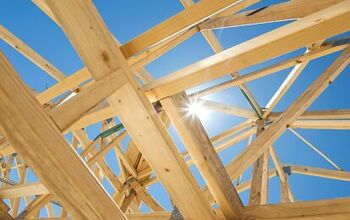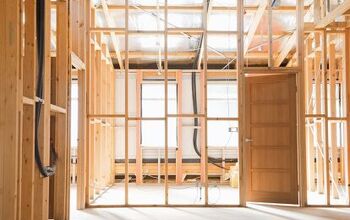How Much Weight Can A Roof Hold?

Your roof is a crucial part of your home. It prevents the elements from leaking into your home, and it also helps keep your home insulated and secure. For some, a roof is even a beautiful and relaxing part of the dwelling. Roof decks and rooftop living areas have become increasingly common.
Not all roofs are the same. Some are much stronger than others. Before you plan on building an addition on a roof, or even walking out on one, you should ask yourself, “how much can a roof hold?”
Materials, design, workmanship, and roof age all factor into how much weight a roof can hold. Most areas have building codes. These codes usually require that a roof can hold a minimum of 20 pounds per square foot, or 300 concentrated pounds. In addition to checking building codes, you should understand the difference between a roof’s dead load, live load, and total load.
Do You Need Roofing, Siding, or Gutter Installers?
Get free, zero-commitment quotes from pro contractors near you.

Variables That Affect Roof Strength
- Age. As with all things, roofs weaken over time. Your roof may have been up to code and able to handle more than 30 pounds per square foot. As time passes, the roof’s strength will begin to diminish.
- Roofing Materials Used. There are several layers to a roof. All of the layers play a part in how much a roof can hold.
- Trusses and beams that are part of the building’s skeleton dictate how much weight the building itself can withstand.
- Roof decking (or sheathing) material used also affects the amount of weight your roof can hold.
- The type of shingles used can not only affect the longevity of your roof, but also its weight threshold.
- Structural Integrity. The Design of the home and the roof have a direct correlation in how much weight your roof can hold. This means everything from the type of beams and trusses, to the style of roof, all play a factor in how much weight your roof can hold.
- Quality Of Work. You can have a great design and top materials, but if it is poorly installed your roof will not be as strong as it should be. Ensuring you hire quality professionals also ensures your roof can hold its maximum weight potential.
Live Load vs. Dead Load vs. Total Load
It is critical that you consider exactly what “weight” you are referring to when you ask how much weight your roof can hold. There are several different types of weight, or “loads” considered by roofers and building designers. These types of weight are called “live load,” “dead load,” and “total load.” Understanding what each type means will help determine exactly what type of weight you are looking for.
Dead Load
A dead load is the amount of weight the roof is already holding even when nothing additional is on it. The dead weight of your roof is normally the weight of the roof itself (its shingles, sheathing, etc.) and any objects that live permanently on the roof. Any piping, satellites or installed structures are also calculated into a roof’s dead load.
Live Load
Where a dead load is the weight that your roof is always holding, a live load is its temporary weight. Live loads include snow, temporary structures or even maintenance workers walking on your roof.
Total Load
The total load is the total combination of a roof’s dead load and live load. A total load is, then, every last bit of weight that your roof is holding up. If your roof reaches or exceeds its total load limitations it is at risk of damage or even collapse.
Types Of Roof That Can Hold The Most Weight
Although there are numerous factors that determine how much weight a roof can hold, flat roofs can typically hold the most weight. The main reason for this is that flat roofs are often designed to withstand the most weight.
Flat roofs often must hold more weight than angled roofs. The excess weight can be anything from excessive rain and snow buildup to the need to install temporary permanent structures. Flat roofs are also commonly built upon. Any roof that will be built upon must be able to withstand all the weight of an additional story.
Check Your Building Codes
Just like with many aspects of home building and design, roof strength factors into most modern building codes. For example, some building codes require that a roof must be able to withstand 20 pounds per square foot.
Other building codes require a roof to withstand a concentrated weight of 300 pounds. This means a roof should be able to hold 300 pounds in a single space. Check in to your local building codes to know the minimums for your area. This should give you an idea of how much weight your roof can hold.
Signs Your Roof Can Not Handle The Weight
Your roof may have normal capacities and be fully up to code. In most circumstances, this means you should be able to determine approximately how much weight your roof can hold. Before you test the limits of your roof, however, you should look over the area thoroughly.
There are several characteristics you should look out for that could indicate a roof that is weakened and unable to hold its weight.
- Cracks on the Walls, Ceiling, or Outer Facade
- Sloped Or Sagging Roof
- Your Roof Is Making Strange Noises
- The Roof Looks Noticeably Damaged
- A Consistently Leaky Roof
- Other Parts of Home Look Off Centered
Ways To Make Your Roof Stronger
- Stiffen Trusses by connecting wood to the trusses along the home.
- Look For Damaged Shingles. Damaged shingles are a sign of a weakening roof, or a roof in need of repair. If you see loose or missing shingles- repair them and ensure the area around them is secure.
- Clean The Gutters. This will help remove some unnecessary dead weight. Cleaning your gutters also ensures that any rain or snow is quickly drained off your roof, rather than weighing it down for prolonged periods.
- Caulk and Fill Vulnerable Areas. Applying a strong caulk to any corner, potential opening or vulnerable area reduces risk of leaking and flooding. This will help maintain your roof’s integrity.
- Lift Shingles, Add Roofing Cement. If your shingles are in good condition you can try lifting them and adding a layer of roofing cement. This will strengthen the area between the shingles and roof decking. The roofing cement will add a bit more protection and strength.
Hire A Professional To Determine Your Roof’s Capabilities
It is best to hire a professional If you have a specific question about your roof or are looking to test its strength. A trained professional can determine the quality of your roof, investigate what lies underneath its shingles, and make a determination.
It is always best to have a trained professional tell you how much weight your roof can hold. This can help you avoid potential damage and even potential safety risks.
Do You Need Roofing, Siding, or Gutter Installers?
Get free, zero-commitment quotes from pro contractors near you.

Related Questions
Can I walk On My Roof?
A common reason people ask how much weight their roof can hold is that they want to know if their roof can withstand their body weight. The short answer is; maybe. If you have a newer roof and it is up to most current building codes, then your roof will likely be built to withstand the weight of a 200 to 300 pound individual. Remember there are always a variety of factors to consider before you step on your roof, and it is always best to avoid walking on your roof if at all possible.

Tom Gaffey is an expert writer who currently resides in Washington D.C. Tom has a passion for real estate and home improvement writing, as well as travel and lifestyle writing. He lived the last twelve years in Hawaii where he worked closely with luxury resorts and event planners, mastering his knowledge of aesthetics and luxury products. This is where he found his passion for home improvement and a keen interest in DIY projects. Currently, Tom resides in Washington D.C, and also working on his debut fiction novel.
More by Tom Gaffey























![How To Reset A Whirlpool Cabrio Washer [In 5 Easy Steps!]](https://cdn-fastly.upgradedhome.com/media/2023/07/31/9076531/how-to-reset-a-whirlpool-cabrio-washer-in-5-easy-steps.jpg?size=350x220)



